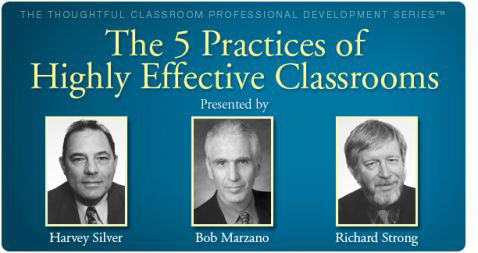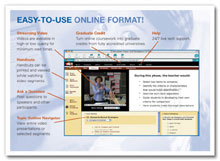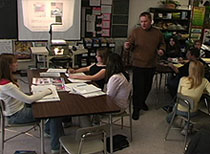

LEARNING ONLINE WAS NEVER SO EASY!
Across the country, The Thoughtful Classroom Program is helping schools and districts to create learning communities where student achievement is on the rise and state test scores are soaring. Now the principles and practices of The Thoughtful Classroom are available in a new online training program: The 5 Practices of Highly Effective Classrooms. The 5 Practices brings together some of the brightest minds in education Robert Marzano, Harvey Silver, and Richard Strong in a five-hour program packed with inspiring lectures, informative classroom examples with real teachers and students, and an engaging array of supplemental material.
 |
 |
| (click on image for larger view) | (click on image to see a video clip) |
THE 5 PRACTICES OF HIGHLY EFFECTIVE CLASSROOMS IN A NUTSHELL
Designed for teachers and administrators alike, The 5 Practices of Highly Effective Classrooms online professional development course allows participants to:
- "Attend" a set of online lectures in which Dr. Silver, Dr. Marzano, and Richard Strong discuss how 30 years of research and practice led to The 5 Practices, and explain the rich research base supporting these practices.
- Look in on real classrooms as teachers show how to put each practice into action.
- Hear real students talk about their growth and increased self-awareness as learners.
- Discover powerful techniques that allow teachers and administrators to work together to improve practice.
- Learn from principals and administrators how to create and take an active role in a professional learning community that supports teachers as they incorporate new strategies into their classrooms.
- Download activity-based curriculum guides that facilitate deeper learning.
And much more!
THE 5 PRACTICES OF HIGHLY EFFECTIVE CLASSROOMS ANSWERS THESE QUESTIONS:
1. What skills must students learn in order to achieve at high levels?
PRACTICE ONE: The Hidden Skills of Academic Literacy
- Richard Strong presents the Hidden Skills - a concise list of skills that separate high achievers from low and average achievers.
- Classroom teachers show how they build key Hidden Skills such as vocabulary management.
2. What instructional strategies enable the greatest gains in student performance?
PRACTICE TWO: Research-Based Instructional Strategies
- Dr. Marzano explains the connections between memory and effective learning; Dr. Silver, Richard Strong, and Dr. Marzano explore comparison strategies in depth.
- Teachers at various grade levels and content areas show how they use comparison in their classrooms.
3. How can we address the diversity of our students in a manageable way while still providing opportunities for all students to achieve?
PRACTICE THREE: Diversity That Works
- Dr. Silver discusses how a learning-style-based model of differentiation can be used to engage and motivate all learners.
- Students describe their own experiences as learners and explain how their own learning styles affect their experiences in school.
- Dr. Silver discusses how a learning-style-based model of differentiation can be used to engage and motivate all learners.
- Students describe their own experiences as learners and explain how their own learning styles affect their experiences in school.
4. How can we design lessons and units that motivate learners yet still address the skills and core content knowledge that students need to achieve?
PRACTICE FOUR: Classroom Curriculum Design
- Dr. Silver and Richard Strong present a simple and deep unit design model that incorporates the Hidden Skills, research-based strategies, learning styles, and research on student motivation.
- Teachers meet in Learning Clubs to discuss units, share their experiences, evaluate student work, and help each other raise student achievement.
- Dr. Silver and Richard Strong present a simple and deep unit design model that incorporates the Hidden Skills, research-based strategies, learning styles, and research on student motivation.
- Teachers meet in Learning Clubs to discuss units, share their experiences, evaluate student work, and help each other raise student achievement.
5. How do schools become professional learning communities that support teachers through the improvement process?
PRACTICE FIVE: Instructional Leadership Teams
- Richard Strong lectures on the importance of creating collaborative school structures in which teachers and administrators support each other as they learn.
- Teachers and administrators conduct a real leadership meeting showing how they manage the improvement process.
- Richard Strong lectures on the importance of creating collaborative school structures in which teachers and administrators support each other as they learn.
- Teachers and administrators conduct a real leadership meeting showing how they manage the improvement process.
COMBINE ON-SITE TRAINING AND ONLINE LEARNING, AND SAVE!
Now you can ignite the passion for professional learning among your staff with this powerful combination of on-site training and online learning. Our one- and two-day professional development training packages will provide a common focus for your faculty, allow you to link course content to the most current topics in educational research and policy, and customize your schoolÂs training experience. For example, combine our online training program The 5 Practices of Highly Effective Classrooms with on-site training focusing on:
- Why Students Fail and What We Can Do About It
- Helping Struggling and At-Risk Learners Succeed
- Differentiated Instruction and Assessment
- Tools and Strategies for Student Engagement
- Special Education
Or call today and speak with one of our senior consultants about training combinations to fit your specific school or district needs.
The 5 Practices of Highly Effective Classrooms
Online Program
1-19 . . . .$150 per person,
20-99. . . . $120 per person,
100-499. . .$95 per person,
500+. . . . . $50 per person,
Online purchase of The 5 Practices of Highly Effective Classrooms is not currently available.
To order, call (800) 962-4432 or email questions@takeassessments.com.


